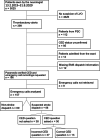Cortical symptoms described in emergency calls for patients with suspected large vessel occlusion: a descriptive analysis of 157 emergency calls
- PMID: 35962313
- PMCID: PMC9375237
- DOI: 10.1186/s12873-022-00706-5
Cortical symptoms described in emergency calls for patients with suspected large vessel occlusion: a descriptive analysis of 157 emergency calls
Abstract
Background: Emergency medical dispatchers typically use the dispatch code for suspected stroke when the caller brings up one or more symptoms from the face-arm-speech triad. Paramedics and emergency department physicians are trained to suspect large vessel occlusion stroke when the stroke patient presents with hemiparesis and cortical symptoms: neglect, aphasia, and conjugate eye deviation (CED). We hypothesized that these symptoms could be evident in the emergency call. In this study, we aimed to describe common symptoms mentioned in the emergency calls for paramedic-suspected thrombectomy candidates. Secondly, we wanted to explore how the question about CED arises in the Finnish suspected stroke dispatch protocol. Our third aim was to find out if the symptoms brought up in suspected stroke and non-stroke dispatches differed from each other.
Methods: This was a retrospective study with a descriptive analysis of emergency calls for patients with paramedic-suspected large vessel occlusion stroke. We listened to the emergency calls for 157 patients transported to Tampere University Hospital, a Finnish comprehensive stroke centre. Two researchers listened for symptoms brought up in these calls and filled out a pre-planned case report form.
Results: Speech disturbance was the most common symptom brought up in 125 (80%) calls. This was typically described as an inability to speak any words (n = 65, 52% of calls with speech disturbance). Other common symptoms were falling down (n = 63, 40%) and facial asymmetry (n = 41, 26%). Suspicion of stroke was mentioned by 44 (28%) callers. When the caller mentioned unconsciousness the emergency dispatcher tended to use a non-stroke dispatch code. The dispatchers adhered poorly to the protocol and asked about CED in only 57% of suspected stroke dispatches. We found CED in 12 emergency calls and ten of these patients were diagnosed with large vessel occlusion.
Conclusion: In cases where paramedics suspected large vessel occlusion stroke, typical stroke symptoms were described during the emergency call. Speech disturbance was typically described as inability to say anything. It is possible to further develop suspected stroke dispatch protocols to recognize thrombectomy candidates from ischemic cortical signs such as global aphasia and CED.
Keywords: Emergency medical dispatch; Emergency medical services; Large vessel occlusion stroke.
© 2022. The Author(s).
Conflict of interest statement
The authors have no conflicts of interest.
Figures



References
-
- Benjamin EJ, Virani SS, Callaway CW, Chamberlain AM, Chang AR, Cheng S, et al. American Heart Association Council on epidemiology and prevention: statistics committee and stroke statistics subcommittee. Heart disease and stroke statistics, 2018 update: a report from the American Heart Association. Circulation. 2018;137(12):e67–e492. doi: 10.1161/CIR.0000000000000558. - DOI - PubMed
-
- Boodt N, Compagne KCJ, Dutra BG, Samuels N, Tolhuisen ML, Alves HCBR, et al. Coinvestigators MR CLEAN registry. Stroke etiology and Thrombus computed tomography characteristics in patients with acute ischemic stroke: an MR CLEAN registry substudy. Stroke. 2020;51(6):1727–1735. doi: 10.1161/STROKEAHA.119.027749. - DOI - PubMed
-
- Powers WJ, Rabinstein AA, Ackerson T, Adeoye OM, Bambakidis NC, Becker K, Biller J, et al. Guidelines for the early Management of Patients with Acute Ischemic Stroke (2019 update to the 2018 guidelines): a guideline for healthcare professionals from the American Heart Association/American Stroke Association. Stroke. 2019;50(12):e344–e418. doi: 10.1161/STR.0000000000000211. - DOI - PubMed
-
- Turc G, Bhogal P, Fischer U, Khatri P, Lobotesis K, Mazighi M, et al. European stroke organisation (ESO) and European Society for Minimally Invasive Neurological Therapy (ESMINT) guidelines on mechanical Thrombectomy in acute ischemic stroke. J Neurointerv Surg. 2019;11(6):535–538. doi: 10.1136/neurintsurg-2018-014568. - DOI - PubMed
Publication types
MeSH terms
LinkOut - more resources
Full Text Sources
Medical
Miscellaneous

